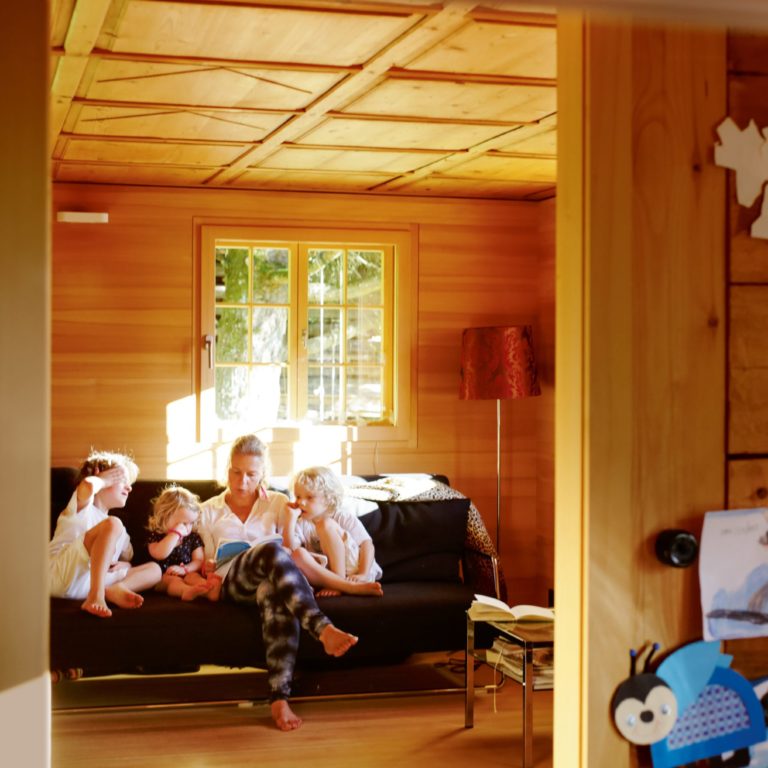
C Familie Brugger Montafon alt neu (c) Peter Rigaud
What’s new from the past
You wouldn’t know just by looking at the historic stone and wooden façade how contemporary the interior of the Brugger family

C Familie Brugger Montafon alt neu (c) Peter Rigaud
You wouldn’t know just by looking at the historic stone and wooden façade how contemporary the interior of the Brugger family
The residence is positioned directly on the steep slope in Vorarlberg’s Montafon valley and is a tribute to the concept of “preserving what’s worth preserving”
TEXT: JULIA GROSSE
The son is standing with his bike in front of his parents’ house, built in 1750, and is wearing a T-shirt that says, “I love NY”. New York and nature look rather well together in this place. And this unusual juxtaposition is basically the perfect illustration of what the Brugger family has achieved here in such a unique fashion: they live in an old build where the exterior conceals the fact that the interior is so up to date.
Visitors winding their way up the road from the valley for the first time will really not be aware that – behind the historic and highly rustic-looking façade – a family of five is at that moment relaxing on reduced designer chairs or working on an iMac. The building, which at the time was erected economically from stone and spruce wood, was owned by the family of Otto Brugger, who occasionally spent time here as a child. The reason why the architect gave the historic building in Bartholomäberg a second chance at all was simply that its structure and materials remained sound. “The old build hadn’t been modernised and destroyed beyond all recognition.” Although the family did have to scrape their way through endless layers of wallpaper on the inside, the façade remained as unaltered as possible. The result is a home that celebrates the sustainability adage that demands the “preservation of what’s worth preserving” in an innovative style.
It hadn’t been modernised and destroyed beyond all recognition.
“We definitely didn’t want to put new details in place and then pretend that they had always been a part of the historic structure,” says Otto Brugger and runs his hand over one of the old walls. You can clearly see where the old bits end and the new ones begin: elements such as the white kitchen and stairs are obviously new while the beams and one or the other wall pocked with woodworm are, in contrast, ancient and atmospheric.
Upstairs provides space for the parents and the three children. The bathroom, made entirely from wood, is also located here. The kitchen, study, dining room and living room around the central wood burner that heats up the water for the family and heating are located downstairs. All this functions simply and holistically so that the Brugger family may justifiably claim that they are using their house almost as energy-efficiently as their forebears. The burner is fired up once a day, which, says the father of the family, doesn’t take longer than brushing your teeth thoroughly in the evening.
The family appreciates and utilises the versatility of wood across every square metre of space and only falls back on new materials when absolutely necessary. But for all of this, Katrin Brugger had originally dreamt of living in a reduced glass-and-concrete structure. “Although now I couldn’t imagine being anywhere else but in this house.” Which is certainly not least due to the fact that it always seems as if Mother Nature had chosen this building specifically to stage her seasonal plays. Long shadows wander across the rooms in winter and then you’re nestling within a lush green lung in summer.
If children are going to get a feeling for the change of seasons anywhere, then it’s up here
The family’s outlook has also changed since it moved here, a change that results not least from the windows. They previously lived in a window-roofed attic apartment, so in contrast their present home appears very miserly where wide vistas of the landscape are concerned: the family is no longer able to enjoy generous panoramic views through the small windows that were rebuilt true to the original details. But that does have its benefits, says Otto Brugger. Because these small openings sharpen your eye for specific aspects of the breathtaking panorama much more intensively: it’s as if you were admiring them through a telescope. “We’ve really come to appreciate this,” the owner says. So all the rooms now have a great view of the Silvretta and Rätikon mountains, with the Rodund reservoir at their feet.
In winter, the five feel as if they’re living in a snow paradise and, in summer, as if they’re in the middle of a green panorama. And the supposed solitude is deceptive. That’s because the nearest neighbour lives in sight just a bit further down the slope but the main reason is because the family is always able to enjoy the best of company: “There are eagles, deer, hares, badgers and foxes here!” The family uses the garden to grow vegetables such as the delicious potatoes that are cultivated under straw.
Outside, the sun disappears lazily behind the mountains while Otto Brugger turns the lights on inside. The two boys are having a last race, bike against scooter, down the gravel path in front of the house while the little sister chases giggling after them, the meadow next to it drops steeply downwards. “The children have got totally used to the steep drop,” says the mother calmly.
The fact that they don’t know any different means that their instinct is to be careful. It’s different when we’re in a big city. In New York, for example, they can’t believe that the cars just won’t stop for them…
Otto Brugger built and designed his home himself.